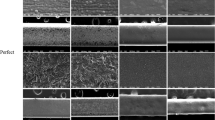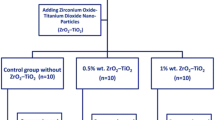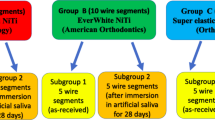Abstract
Dissolution–reformation cycle of the passive oxide layer on the nickel–titanium (NiTi) orthodontic archwires was investigated, which has recently been recognized as one of the key parameters dictating the biocompatibility of archwires. Specifically, commercially available NiTi orthodontic archwires were immersed in artificial saliva solutions of different pH values (2.3, 3.3, and 4.3) for four different immersion periods: 1, 7, 14, and 30 days. Characterization of the virgin and tested samples revealed that the titanium oxide layer on the NiTi archwire surfaces exhibit a dissolution–reformation cycle within the first 14 days of the immersion period: the largest amount of Ni ion release occurred within the first week of immersion, while it significantly decreased during the reformation period from day 7 to day 14. Furthermore, the oxide layer reformation was catalyzed on the grooves within the peaks and valleys due to relatively larger surface energy of these regions, which eventually decreased the surface roughness significantly within the reformation period. Overall, the current results clearly demonstrate that the analyses of dissolution–reformation cycle of the oxide layer in orthodontic archwires, surface roughness, and ion release behavior constitute utmost importance in order to ensure both the highest degree of biocompatibility and an efficient medical treatment.








Similar content being viewed by others
Notes
3M Unitek Nitinol heat-activated archwires with 0.36 mm diameter were used in the experiments.
References
Tian H, Schryvers D, Liu D, Jiang Q, Van Humbeeck J (2011) Stability of Ni in nitinol oxide surfaces. Acta Biomater 7(2):892–899
Toker SM, Canadinc D, Maier HJ, Birer O (2014) Evaluation of passive oxide layer formation-biocompatibility relationship in NiTi shape memory alloys: geometry and body location dependency. Mater Sci Eng C 36:118–129
Trepanier C, Venugopalan R, Pelton AR (2000) Corrosion resistance and biocompatibility of passivated NiTi. Springer, Berlin Heidelberg
Zhu L, Trépanier C, Pelton AR, Fino J (2003) Oxidation of nitinol and its effect on corrosion resistance. Med Device Mater. doi:10.1361/cp2003mpmd156
Machado LG, Savi MA (2003) Medical applications of shape memory alloys. Braz J Med Biol Res 36(6):683–691
Shabalovskaya SA, Rondelli GC, Undisz AL, Anderegg JW, Burleigh TD, Rettenmayr ME (2009) The electrochemical characteristics of native Nitinol surfaces. Biomaterials 30(22):3662–3671
Duerig T (2002) The use of superelasticity in modern medicine. MRS Bull 27(02):101–104
Ryhänen J, Niemi EUOO, Serlo W, Niemelä E, Sandvik P, Pernu H, Salo T (1997) Biocompatibility of nickel-titanium shape memory metal and its corrosion behavior in human cell cultures. J Biomed Mater Res 35(4):451–457
Toker SM, Canadinc D (2014) Evaluation of biocompatibility of NiTi dental wires: a comparison of laboratory experiments and clinical conditions. Mater Sci Eng C 40:142–147
Wever DJ, Veldhuizen AG, Sanders MM, Schakenraad JM, Van Horn JR (1997) Cytotoxic, allergic and genotoxic activity of a nickel-titanium alloy. Biomaterials 18(16):1115–1120
Otsuka K, Ren X (1999) Recent developments in the research of shape memory alloys. Intermetallics 7(5):511–528
Petrini L, Migliavacca F (2011) Biomedical applications of shape memory alloys. J Metall. doi:10.1155/2011/501483
Shabalovskaya SA, Tian H, Anderegg JW, Schryvers DU, Carroll WU, Van Humbeeck J (2009) The influence of surface oxides on the distribution and release of nickel from Nitinol wires. Biomaterials 30(4):468–477
Hu T, Chu C, Xin Y, Wu S, Yeung KW, Chu PK (2010) Corrosion products and mechanism on NiTi shape memory alloy in physiological environment. J Mater Res 25:350–358
Li X, Wang J, Han EH, Ke W (2007) Influence of fluoride and chloride on corrosion behavior of NiTi orthodontic wires. Acta Biomater 3(5):807–815
Ma FY (2012) Corrosive effects of chlorides on metals. INTECH Open Access Publisher, Rijeka
Uzer B, Gumus B, Toker SM, Sahbazoglu D, Saher D, Yildirim C, Polat-Altintas S, Canadinc D (2016) A critical approach to the biocompatibility testing of NiTi orthodontic archwires. Int J Metall Metal Phys 1:1–7
Wang J, Li N, Rao G, Han EH, Ke W (2007) Stress corrosion cracking of NiTi in artificial saliva. Dent Mater 23(2):133–137
Castro RM, Smith Neto P, Horta MCR, Pithon MM, Oliveira DD (2013) Comparison of static friction with self-ligating, modified slot design and conventional brackets. J Appl Oral Sci 21(4):314–319
Bourauel C, Fries T, Drescher D, Plietsch R (1998) Surface roughness of orthodontic wires via atomic force microscopy, laser specular reflectance, and profilometry. Eur J Orthod 20(1):79–92
Hanawa T (1999) In vivo metallic biomaterials and surface modification. Mater Sci Eng, A 267(2):260–266
Kim H, Johnson JW (1999) Corrosion of stainless steel, nickel-titanium, coated nickel-titanium, and titanium orthodontic wires. Angle Orthod 69(1):39–44
Huang HH (2005) Surface characterizations and corrosion resistance of nickel-titanium orthodontic archwires in artificial saliva of various degrees of acidity. J Biomed Mater Res 74(4):629–639
Schipper RG, Silletti E, Vingerhoeds MH (2007) Saliva as research material: biochemical, physicochemical and practical aspects. Arch Oral Biol 52(2):1114–1135
Dodds MW, Johnson DA, Yeh CK (2005) Health benefits of saliva: a review. J Dent 33(3):223–233
Diaz-Arnold AM, Marek CA (2002) The impact of saliva on patient care: a literature review. J Prosthet Dent 88(3):337–343
Chicharro JL, Lucía A, Pérez M, Vaquero AF, Ureña R (1998) Saliva composition and exercise. Sports Med 26(1):17–27
Chiappin S, Antonelli G, Gatti R, Elio F (2007) Saliva specimen: a new laboratory tool for diagnostic and basic investigation. Clin Chim Acta 383(1):30–40
Onal O, Gumus B, Aksoy B, Gerstein G, Alaca BE, Maier HJ, Canadinc D (2016) Micro-scale cyclic bending response of NiTi shape memory ally. Mater Trans 57(3):472–475
Corbett RA (2005) Corrosion tests and standards: application and interpretation-second edition. ASTM International, West Conshohocken
Huang HH, Chiu YH, Lee TH, Wu SC, Yang HW, Su KH, Hsu CC (2003) Ion release from NiTi orthodontic wires in artificial saliva with various acidities. Biomaterials 24(20):3585–3592
Kuhta M, Pavlin D, Slaj M, Varga S, Lapter-Varga M, Slaj M (2009) Type of archwire and level of acidity: effects on the release of metal ions from orthodontic appliances. Angle Orthod 79(1):102–110
Firstov GS, Vitchev RG, Kumar H, Blanpain B, Van Humbeeck J (2002) Surface oxidation of NiTi shape memory alloy. Biomaterials 23(24):4863–4871
Ryhänen J (1999) Biocompatibility evaluation of nickel-titanium shape memory metal alloy. Springer, Berlin
Huang HH (2003) Corrosion resistance of stressed NiTi and stainless steel orthodontic wires in acid artificial saliva. J Biomed Mater Res Part A 66(4):829–839
Trepanier C, Tabrizian M, Yahia LH, Bilodeau L, Piron DL (1998) Effect of modification of oxide layer on NiTi stent corrosion resistance. J Biomed Mater Res 43(4):433–440
Acknowledgements
D. Canadinc and O. Birer acknowledge the financial support provided by the Turkish Academy of Sciences (TÜBA) within the Outstanding Young Scientist Program (GEBİP). B. Uzer acknowledges the financial support provided by the Scientific and Technological Research Council of Turkey (TÜBİTAK) within the National Graduate Student Fellowship Program 2211. The SEM, EDX, AFM, and XPS analyses were carried out at Koç University Surface Science and Technology Center (KUYTAM).
Author information
Authors and Affiliations
Corresponding author
Rights and permissions
About this article
Cite this article
Uzer, B., Birer, O. & Canadinc, D. Investigation of the Dissolution–Reformation Cycle of the Passive Oxide Layer on NiTi Orthodontic Archwires. Shap. Mem. Superelasticity 3, 264–273 (2017). https://doi.org/10.1007/s40830-017-0114-3
Published:
Issue Date:
DOI: https://doi.org/10.1007/s40830-017-0114-3




